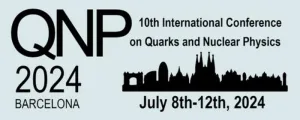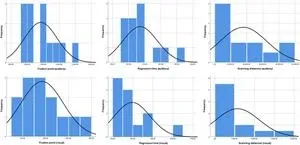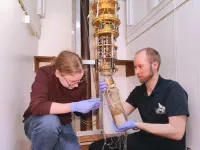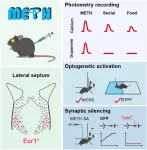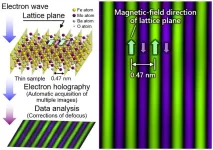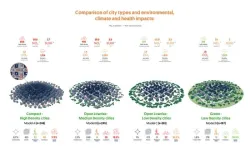(Press-News.org) More than two hundred international experts will take part in the 10th International Conference on Quarks and Nuclear Physics (QNP2024), a scientific summit organized by the UB Institute of Cosmos Sciences (ICCUB), which will be held in the Aula Magna of the Faculty of Biology at the University of Barcelona from 8 to 12 July. This meeting, hosted by the UB for the first time, will bring together world experts in the fields of nuclear physics and hadronic physics to discuss the latest advances in theory, experimentation and technology and to address the scientific challenges of the 21st century regarding the nature and phenomena related to the essential components of matter in the universe.
In previous editions, this date with the world of nuclear physics was held in the cities of Adelaide (Australia), Jülich (Germany), Bloomington (United States), Madrid (Spain), Beijing (China), Palaiseau (France), Valparaíso (Chile), Tsukuba (Japan) and Tallahassee (United States).
The meeting will be inaugurated by the rector, Joan Guàrdia, on Monday, 8 July, in an event in which will participate the professors Xavier Luri and Àngels Ramos, from the Faculty of Physics and the ICC, and M. José García Borge, from the Institute of the Structure of Matter (IEM, CSIC). This will be followed by lectures by Juan M. Nieves, from the University of Valencia, entitled “Charge-conjugation asymmetry and molecular content: the Tcc(3875) and Ds(2317) in nuclear matter”, and Takashi Nakatsukasa, from the University of Tsukuba (Japan), with the paper “Energy density functional approaches to inhomogeneous superfluid neutron-star matter”.
Discovering yet unknown phenomena in nuclear physics
One of the most shocking discoveries in the world of physics was the Higgs boson, announced in July 2012 and postulated theoretically in 1964 by the scientist Peter Higgs to explain the essential building blocks of matter. The discovery is a major milestone at CERN’s Large Hadron Collider (LHC) in Geneva (Switzerland), one of the main scientific infrastructures that are shedding new light on the world of particle physics to understand its nature and the interaction mechanisms that are still unknown to the research community.
“Nuclear and hadronic physics in the 21st century present a number of fascinating scientific challenges, such as the fundamental understanding of strong interactions, the study of new exotic hadrons, the development of more precise nuclear models and the exploration of new states of matter”, says Xavier Luri, professor at the Department of Quantum Physics and Astrophysics and director of the ICCUB.
“It is worth noting that advances in nuclear and hadronic physics have a major impact on other areas of knowledge. In the field of astrophysics, for example, research to create new elements will help to understand the phenomenon of nucleosynthesis in the universe, and studies to characterize the behaviour of nuclear matter under extreme conditions will help to understand the properties and internal composition of neutron stars. In the field of particle physics, experiments on the double beta decay of nuclei, which seek to elucidate the nature of neutrons, will explore the limits of the standard model, while very precise measurements of nuclear and hadronic processes could lead to the detection of dark matter”, adds Luri.
Beyond the standard model of particle physics
The new edition of the international conference will address the limits of knowledge beyond the standard model that describes the most fundamental forces and particles in the universe. Theorists and experimentalists will discuss the progress of recent advances in hadronic and nuclear physics, and share the most revealing results on the structure of quarks and gluons in hadrons, decays and interactions between different particles, cold dark matter and large scientific-technical equipment, among others.
“Very precise measurements of the properties of nuclei and hadronic interactions are needed to discover ‘new physics’ phenomena, i.e. those that cannot be explained by the standard model of particle physics. Sophisticated theoretical studies of certain hadronic processes now show that the degree of precision needed to detect possible candidates for the elusive dark matter (which makes up 85% of the mass of our universe!) is beginning to be achievable in large experimental facilities, such as the Large Hadron Collider (LHC) at CERN”, says Professor Àngels Ramos, head of the UB’s Theoretical Nuclear Physics and Many Interacting Particles Group and coordinator of the conference.
“Another possible manifestation of ‘new physics’ could come from underground laboratories, such as the Canfranc laboratory (LSC), where the so-called double beta decay of nuclei without neutrino emission is being searched for, which will help to elucidate the nature of neutrinos and their mass hierarchy”, says Ramos.
To discuss new research horizons, the conference will feature internationally renowned experts such as Tomohiro Uesaka, head of the Nuclear Dynamics Research Group at the RIKEN centre in Japan, author of significant experimental contributions to the properties of exotic nuclei — rich in neutrons — that test modern theories of nuclear structure; Laura Fabbietti, from the Technical University of Munich (Germany) and the LHC ALICE collaboration, who has led the use of femtoscopy to characterize interactions between unstable hadrons; Yvonne Leifels, head of the Research Division of the Helmholtz Centre for Heavy Ion Research (GSI), who will present the scientific prospects of FAIR (Germany), the ion collider that will allow us to understand how elements are synthesized in the universe or the composition of matter under extreme conditions of density and temperature, and Eulogio Oset, theoretical physicist at the University of Valencia, internationally recognized for his outstanding contributions in the fields of hadronic physics and nuclear physics, and distinguished with the medal of the Royal Spanish Physics Society 2023.
Within the framework of the conference, and in collaboration with the Fundaciño Catalunya La Pedrera, Professor Freya Blekman, from the German Electron Synchrotron (DESY, University of Hamburg), will give the talk “Understanding the Large Hadron Collider: What, why and how?”, on Wednesday 10 July, at 6.30 p.m., in the auditorium of the Casa Milà (La Pedrera). The talk, open to the public, will focus on the research activity at the LHC in Geneva — the Swiss Army Knife of experiments, which investigates everything from new particles and forces to the birth of the universe — without neglecting the more fun and social aspects of this exceptional scientific facility.
The 10th International Conference on Quarks and Nuclear Physics is supported by the Barcelona City Council, the Fundació Catalunya La Pedrera, the International Union of Pure and Applied Physics (IUPAP) and the European Committee for Nuclear Physics Collaboration (NuPECC), which is one of the expert committees of the European Science Foundation (ISF).
END
International summit of experts in nuclear physics at the University of Barcelona
Discovering yet unknown phenomena in nuclear physics
2024-07-04
ELSE PRESS RELEASES FROM THIS DATE:
Clever pupils don’t need to attend academically selective schools to thrive, study finds
2024-07-04
Findings published in a new peer-reviewed paper in the British Journal of Educational Studies challenges the idea that academically selective schools are necessary for clever pupils to achieve good outcomes.
Selective schools are government-funded schools that enrol only the highest performing students. Pupils take a standardized entrance exam, from which the best-scoring are enrolled.
Some argue that selective schools are necessary for bright pupils to reach their full academic potential. Selective schools can ...
Searching for dark matter with the coldest quantum detectors in the world
2024-07-04
One of the greatest mysteries of science could be one step closer to being solved.
Approximately 80% of the matter in the universe is dark, meaning that it cannot be seen. In fact, dark matter is passing through us constantly – possibly at a rate of trillions of particles per second.
We know it exists because we can see the effects of its gravity, but experiments to date have so far failed to detect it.
Taking advantage of the most advanced quantum technologies, scientists from Lancaster University, the University of Oxford, and Royal Holloway, ...
UNSW Sydney's Dr Vaishnavi Ananthanarayanan receives RMS Award for Life Sciences
2024-07-04
This accolade highlights her pioneering research in the use of a diverse array of advanced microscopy techniques to uncover fundamental biophysical processes.
Currently holding a prestigious EMBL (European Molecular Biology Laboratory) Australia Group Leader fellowship, Dr Ananthanarayanan leads one of the largest and most dynamic research group in the EMBL Australia Node in Single Molecule Science, based in the Department of Molecular Medicine in the School of Biomedical Sciences.
Her research, which focuses on motor proteins and cytoskeleton dynamics, has set new standards ...
Researchers unveils a critical role of the lateral septum in drug addiction
2024-07-04
Recently, a research team led by Dr. ZHU Yingjie from the Shenzhen Institute of Advanced Technology, Chinese Academy of Sciences has published a study in Neuron, the study presents a comprehensive transcriptional profile of the lateral septum (LS) at the single-cell level, elucidating the spatial distribution of its major neuronal types. The study shows that neurons expressing estrogen receptor 1 (LSEsr1), predominantly located in the ventral subregion of LS, play a crucial role in reward-seeking and methamphetamine (METH) addiction.
In 1954, psychologists Olds and Milner discovered the brain's reward system through intracranial ...
Efficient hydrogenolysis of 5-hydroxymethylfurfural over Ni-C3N4 catalysts
2024-07-04
Utilization of biomass as the basic feedstock for the production and chemicals and energy storage has been demonstrated to be an important alternative to achieve sustainable society, which has attracted increasing interests in both academic and industrial communities for decades. 5-hydroxymethylfurfural (HMF), one of the most important bio-based platform compounds, could serve as a bridge feedstock between biomass resources and chemicals. It is possible to synthesize a series of high-value added chemicals from HMF through hydrogenation, ...
Hitachi’s holography electron microscope attains unprecedented resolution
2024-07-04
Tokyo, Japan—A research team from Japan, including scientists from Hitachi, Ltd. (TSE 6501, Hitachi), Kyushu University, RIKEN, and HREM Research Inc. (HREM), has achieved a major breakthrough in the observation of magnetic fields at unimaginably small scales. In collaboration with National Institute of Advanced Industrial Science and Technology (AIST) and the National Institute for Materials Science (NIMS), the team used Hitachi’s atomic-resolution holography electron microscope—with a newly developed image acquisition technology and defocus correction algorithms—to visualize ...
An innovative test to diagnose chagas disease in newborns
2024-07-04
An innovative test that combines a DNA extraction system inspired by a modified 3D printer (PrintrLab) with loop-mediated isothermal molecular amplification (LAMP) could be used to detect T. cruzi infection -responsible for Chagas disease- in newborns. This is the conclusion of a proof-of-concept study conducted in the Bolivian Chaco, an endemic area for Chagas disease. The study was coordinated by the Barcelona Institute for Global Health (ISGlobal), a centre supported by "la Caixa" ...
Compact cities have lower carbon emissions, but poorer air quality, less green space and higher mortality rates
2024-07-04
What types of cities exist in Europe and which are more favourable in terms of human health, environmental quality and carbon footprint? To answer these questions, a study led by the Barcelona Institute for Global Health (ISGlobal), a centre supported by the "la Caixa" Foundation, has analysed 919 European cities. The research, published in The Lancet Planetary Health, identified four basic urban configurations on the continent: compact-high density cities, open lowrise-medium density cities, open lowrise-low density cities and green-low density cities. The results show that greener and less densely populated ...
Cuts to processed meat intake bring a range of health benefits
2024-07-04
Reducing consumption of processed meat by around one-third could prevent more than 350,000 cases of diabetes in the US over 10 years, a study suggests.
Cutting US adults’ processed meat intake by 30 per cent – the equivalent of around 10 slices of bacon a week – would also lead to tens of thousands of fewer cases of cardiovascular disease and colorectal cancer, researchers say.
A team from the University of Edinburgh’s Global Academy of Agriculture and Food Systems together with the University of North Carolina, Chapel Hill, has developed ...
Pioneering Code of Practice released for use of stem cell-based embryo models in research
2024-07-04
Stem cell-based embryo models (SCBEMs) are three-dimensional biological structures that mimic aspects of early human embryo development. They can be created in the lab from stem cells, and can provide new insights into critical stages of early human development that are normally inaccessible to researchers.
Embryo model work is expected to lead to new interventions for a range of conditions, including revolutionising treatments for recurrent miscarriage, understanding developmental disorders and improving the success rate of IVF.
Although embryo models are not the same ...
LAST 30 PRESS RELEASES:
Groundbreaking mapping: how many ghost particles all the Milky Way’s stars send towards Earth
JBNU researchers propose hierarchical porous copper nanosheet-based triboelectric nanogenerators
A high-protein diet can defeat cholera infection
A more accurate way of calculating the value of a healthy year of life
What causes some people’s gut microbes to produce high alcohol levels?
Global study reveals widespread burning of plastic for heating and cooking
MIT study shows pills that communicate from the stomach could improve medication adherence
Searching for the centromere: diversity in pathways key for cell division
Behind nature’s blueprints
Researchers search for why some people’s gut microbes produce high alcohol levels
Researchers find promising new way to boost the immune response to cancer
Coffee as a staining agent substitute in electron microscopy
Revealing the diversity of olfactory receptors in hagfish and its implications for early vertebrate evolution
Development of an ultrasonic sensor capable of cuffless, non-invasive blood pressure measurement
Longer treatment with medications for opioid use disorder is associated with greater probability of survival
Strategy over morality can help conservation campaigns reduce ivory demand, research shows
Rising temperatures reshape microbial carbon cycling during animal carcass decomposition in water
Achieving ultra-low-power explosive jumps via locust bio-hybrid muscle actuators
Plant-derived phenolic acids revive the power of tetracycline against drug-resistant bacteria
Cooperation: A costly affair in bacterial social behaviour?
Viruses in wastewater: Silent drivers of pollution removal and antibiotic resistance
Sub-iethal water disinfection may accelerate the spread of antibiotic resistance
Three in four new Australian moms struggle with body image
Post-stroke injection protects the brain in preclinical study
Cardiovascular risk score predicts multiple eye diseases
Health: estimated one in ten British adults used or interested in GLP-1 medications for weight loss
Exercise to treat depression yields similar results to therapy
Whooping cough vaccination for pregnant women strengthens babies’ immune system
Dramatic decline in new cases of orphanhood in Uganda driven by HIV treatment and prevention programs
Stopping weight loss drugs linked to weight regain and reversal of heart health markers
[Press-News.org] International summit of experts in nuclear physics at the University of BarcelonaDiscovering yet unknown phenomena in nuclear physics
